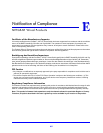
301
XS712T Smart Switch
VLAN Routing with a Static Route
Refer to the following sections to configure VLAN routing with a static route.
VLAN Routing Overview
VLANs divide broadcast domains in a LAN environment. Whenever hosts in one VLAN need
to communicate with hosts in another VLAN, the traffic must be routed between them. This is
known as inter-VLAN routing. On the switch, it is accomplished by creating Layer 3 interfaces
(Switch virtual interfaces (SVI)).
When a port is enabled for bridging (default) rather than routing, all normal bridge processing
is performed for an inbound packet, which is then associated with a VLAN. Its MAC
Destination Address (MAC DA) and VLAN ID are used to search the MAC address table. If
routing is enabled for the VLAN, and the MAC DA of an inbound unicast packet is that of the
internal bridge-router interface, the packet is routed. An inbound multicast packet is
forwarded to all ports in the VLAN, plus the internal bridge-router interface, if it was received
on a routed VLAN.
Since a port can be configured to belong to more than one VLAN, VLAN routing might be
enabled for all of the VLANs on the port, or for a subset. VLAN Routing can be used to allow
more than one physical port to reside on the same subnet. It could also be used when a
VLAN spans multiple physical networks, or when additional segmentation or security is
required. A port can be either a VLAN port or a router port, but not both. However, a VLAN
port can be part of a VLAN that is itself a router port.
Sample VLAN Routing Configuration
Complete these steps to configure a switch to perform interVLAN routing.
1. Use the VLAN Configuration screen to enable routing on the switch (see Basic VLAN
Configuration on page 85).
2. Determine the IP addresses you want to assign to the VLAN interface on the switch. For the
switch to be able to route between the VLANs, the VLAN interfaces must be configured with
an IP address. When the switch receives a packet destined for another subnet/VLAN, the
switch looks at the routing table to determine where to forward the packet. The packet is
then passed to the VLAN interface of the destination. It is then sent to the port where the
end device is attached.
3. Configure the VLAN interfaces (by selecting the VLAN; VLANs have to be created statically
and ports have to added by using VLAN configuration screens. Refer to the example of
configuring VLAN) with the IP address identified using the VLAN Routing Configuration. e.g.
IP address 10.1.2.1 and mask 255.255.255.0
4. Repeat this process for all VLANs identified to be configured as the routing interfaces.


















